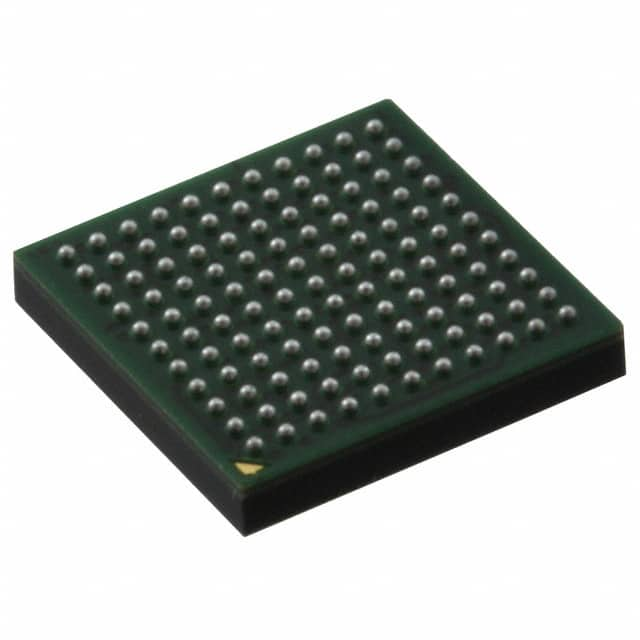MK20DX256VMC7R
Introduction
The MK20DX256VMC7R is a microcontroller belonging to the Kinetis family of ARM Cortex-M4 based devices. This entry provides an overview of the product, including its category, use, characteristics, package, specifications, pin configuration, functional features, advantages and disadvantages, working principles, application field plans, and alternative models.
Product Overview
- Category: Microcontroller
- Use: The MK20DX256VMC7R is designed for embedded applications that require high-performance processing and low power consumption.
- Characteristics: It features a 32-bit ARM Cortex-M4 core, extensive connectivity options, and a wide range of peripherals suitable for various applications.
- Package: The MK20DX256VMC7R is available in a compact and durable package suitable for surface mount assembly.
- Essence: The essence of this microcontroller lies in its ability to provide advanced processing capabilities while maintaining energy efficiency.
- Packaging/Quantity: The microcontroller is typically supplied in tape and reel packaging with varying quantities depending on the supplier and order size.
Specifications
- Core: ARM Cortex-M4
- Clock Speed: Up to 72 MHz
- Flash Memory: 256 KB
- RAM: 64 KB
- Operating Voltage: 1.71V to 3.6V
- I/O Pins: 34
- Interfaces: USB, I2C, SPI, UART, CAN
Detailed Pin Configuration
For detailed pin configuration, please refer to the official datasheet provided by the manufacturer.
Functional Features
- High-Performance Processing: The MK20DX256VMC7R offers a powerful ARM Cortex-M4 core, enabling efficient execution of complex tasks.
- Rich Peripheral Integration: It includes a wide range of peripherals such as timers, ADCs, DACs, and communication interfaces, enhancing its versatility for different applications.
- Low Power Consumption: The microcontroller is designed to operate efficiently in low-power modes, making it suitable for battery-powered devices.
Advantages and Disadvantages
Advantages
- High processing power
- Extensive peripheral integration
- Low power consumption
- Wide operating voltage range
Disadvantages
- Limited availability of alternative models
- Relatively higher cost compared to some competing microcontrollers
Working Principles
The MK20DX256VMC7R operates based on the ARM Cortex-M4 architecture, utilizing its advanced features to execute instructions and manage peripherals. It employs low-power modes to optimize energy efficiency while delivering high performance.
Detailed Application Field Plans
The MK20DX256VMC7R is well-suited for a variety of embedded applications, including: - Industrial control systems - Consumer electronics - Internet of Things (IoT) devices - Automotive systems - Medical devices
Detailed and Complete Alternative Models
While the MK20DX256VMC7R offers robust features, alternative models from the same family or other manufacturers include: - MK22FN512VLH12 - STM32F407VG - LPC1768
In conclusion, the MK20DX256VMC7R microcontroller presents a compelling solution for embedded systems requiring a balance of performance and power efficiency. Its rich feature set and versatile applications make it a valuable choice for various industries.
Word count: 470
قم بإدراج 10 أسئلة وإجابات شائعة تتعلق بتطبيق MK20DX256VMC7R في الحلول التقنية
What is the MK20DX256VMC7R microcontroller used for?
- The MK20DX256VMC7R microcontroller is commonly used in embedded systems, industrial control, and consumer electronics applications.
What are the key features of the MK20DX256VMC7R?
- The MK20DX256VMC7R features a 32-bit ARM Cortex-M4 core, 256KB flash memory, 64KB RAM, multiple communication interfaces, and analog peripherals.
How can I program the MK20DX256VMC7R microcontroller?
- The MK20DX256VMC7R can be programmed using various integrated development environments (IDEs) such as Keil, IAR Embedded Workbench, or using open-source tools like PlatformIO and Arduino.
What are the typical power requirements for the MK20DX256VMC7R?
- The MK20DX256VMC7R operates at a voltage range of 1.71V to 3.6V, making it suitable for low-power applications.
Can the MK20DX256VMC7R interface with external sensors and devices?
- Yes, the MK20DX256VMC7R supports various communication interfaces such as SPI, I2C, UART, and CAN, allowing it to interface with a wide range of sensors and devices.
Is the MK20DX256VMC7R suitable for real-time applications?
- Yes, the MK20DX256VMC7R's ARM Cortex-M4 core and hardware floating-point unit make it well-suited for real-time processing and control applications.
What kind of development tools are available for the MK20DX256VMC7R?
- Freescale (now NXP) provides a comprehensive suite of development tools including evaluation boards, software libraries, and documentation for the MK20DX256VMC7R.
Can the MK20DX256VMC7R be used in automotive applications?
- Yes, the MK20DX256VMC7R is suitable for automotive applications due to its robust design, temperature range, and support for communication protocols commonly used in automotive systems.
Are there any known limitations or issues with the MK20DX256VMC7R?
- While the MK20DX256VMC7R is a reliable microcontroller, users should be aware of potential issues related to clock configuration, peripheral conflicts, and memory constraints when designing their applications.
Where can I find technical support and resources for the MK20DX256VMC7R?
- NXP's website, community forums, and technical support channels provide valuable resources for developers working with the MK20DX256VMC7R, including datasheets, application notes, and reference designs.


